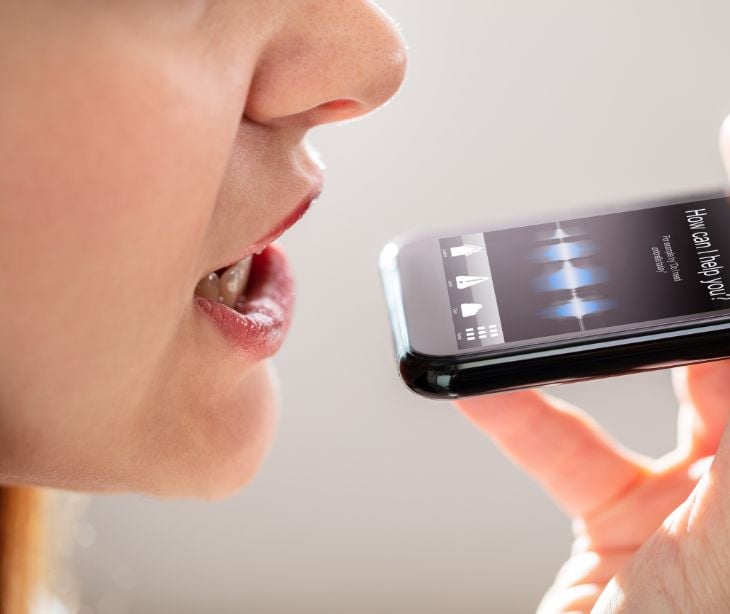
The global speech-to-text API market size, valued at USD 2.32 billion in 2021, is projected to experience strong growth. This growth shows great potential in many sectors, including healthcare. The technology, which powers applications like smartphone voice-to-text features, virtual assistants like Siri and Alexa, and transcription services, enables effortless speech conversion into textual format. Speech to text can be tailored to meet the requirements of HIPAA compliance.
How speech to text technology works
A paper titled, The future of text-to-speech technology: How long before it’s just one more thing we do when teaching reading?, starts us off with a clear definition of what text to speech covers, “Text-to-speech technology (TTST) most often falls under the heading of special education or assistive technology…”
Speech to text technology actively transforms spoken language into written text through a dynamic and multi-step process. Initially, it captures audio data, typically through a microphone, and then digitizes this analog sound into a digital audio format. This digital audio is processed by sophisticated algorithms that break it down into smaller, manageable segments. These segments are analyzed for phonemes, the distinct units of sound in a language.
The technology then utilizes advanced natural language processing (NLP) techniques, which compare these phonemes against a comprehensive language model. This model contains vast databases of words, phrases, and syntactical patterns, enabling the system to accurately interpret and transcribe the spoken words into coherent, written sentences.
Throughout this process, the system continuously refines its interpretations based on context, speaker accent, and dialect variations, ensuring a high level of accuracy in the transcription. The result is a text output that accurately reflects the spoken input, efficiently bridging the gap between verbal communication and written documentation.
Use cases in healthcare
- Clinical documentation
- Telehealth services
- Medical transcription
- Voice-activated health records
- Accessibility for disabled healthcare professionals
- Communication with patients with disabilities
The requirements for HIPAA compliance
HIPAA compliance includes taking measures such as designating a HIPAA Privacy Officer, understanding PHI, managing patient access requests, and performing due diligence on business associates. These requirements are set out in HIPAA’s:
HIPAA Privacy Rule
This rule sets the standards for the use and disclosure of protected health information (PHI) by covered entities. It aims to protect the privacy of PHI while allowing the necessary flow of health information for high-quality healthcare and public health and well-being. The rule permits certain uses of PHI without an individual's authorization for specific purposes like treatment, payment, healthcare operations, and certain public interest and benefit activities.
HIPAA Security Rule
This rule specifically protects electronic PHI (ePHI). Covered entities must ensure the confidentiality, integrity, and availability of all ePHI they handle. This involves protecting against anticipated threats, safeguarding against impermissible uses or disclosures, and ensuring workforce compliance.
See also: What is the key to HIPAA compliance?
How to ensure that your speech to text technology is HIPAA compliant
When selecting a HIPAA compliant speech-to-text service for healthcare organizations, there are several key factors to consider:
- HIPAA compliance and security: The service must comply with HIPAA regulations, addressing all security and privacy concerns. This includes encrypting PHI both at rest and in transit and having robust mechanisms to protect against unauthorized access.
- Accuracy and medical vocabulary: The service should offer high accuracy in transcription and be able to understand and transcribe medical terminology.
- Integration with existing systems: The speech-to-text solution should seamlessly integrate with existing EHR systems and other healthcare tools such as HIPAA compliant email. This integration aids in streamlining workflows and maximizing efficiency.
- User authentication: The service should have robust user authentication protocols to ensure that only authorized personnel can access PHI.
- Real-time transcription capabilities: The ability to process speech-to-text in real time without extended delays allows for dynamic healthcare environments.
- Multilingual support: Multilingual capabilities can be an advantage for healthcare providers serving diverse populations.
- Customization and flexibility: The service should offer the ability to customize based on the specific needs of the healthcare provider, such as accommodating different accents or speech patterns.
- Support and maintenance: Ongoing support and maintenance are necessary, especially with evolving healthcare environments and technological advancements.
- Business associate agreement (BAA): Ensure that the service provider is willing to sign a BAA, which is a contract that stipulates how a business associate will handle PHI in compliance with HIPAA guidelines.
See also: Is AWS Transcribe HIPAA compliant?
FAQs
Can speech-to-text technology ensure privacy of PHI?
Speech-to-text technology alone cannot ensure the privacy of PHI. However, when used with appropriate security measures such as encryption, access controls, user authentication, and compliance with privacy regulations like HIPAA, it can contribute to safeguarding PHI privacy.
Are cloud-based speech-to-text services HIPAA compliant?
Yes, cloud-based speech-to-text services can be made HIPAA compliant when the service provider implements appropriate security measures and signs a business associate agreement (BAA) with covered entities, ensuring they adhere to HIPAA regulations in handling Protected Health Information (PHI).
Subscribe to Paubox Weekly
Every Friday we'll bring you the most important news from Paubox. Our aim is to make you smarter, faster.




